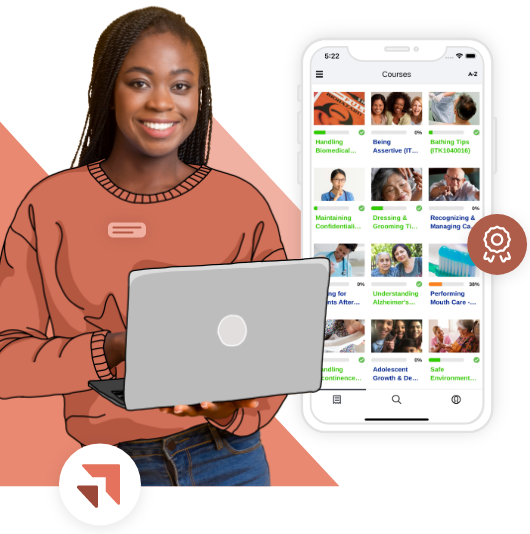Last year, 95.5% of agencies reported that caregiver shortages had an impact on their business. Here’s how an employment brand can help.
At one point or another, every home care agency owner has contemplated how to wage the talent war.
According to the 2021 Home Care Benchmarking Study, just last year, 95.5% of agencies reported that caregiver shortages had an impact on their business.
With the increasing threat of caregiver shortages, you might be asking yourself, what else can I do to get caregiver applicants when there simply aren’t enough to go around?
The simple answer? Build an employment brand that brings caregivers to you.
Whether or not you’re facing hiring challenges, an employment brand is still important. It gives your recruitment and retention efforts a face and presents a larger image that you’re a great company to work for.
What is an employment brand?
During one of our recent lunch-and-learn presentations with the internal team here at Home Care Pulse, we talked a bit about branding.
While the subject matter undeniably caused some laughter, we wanted to share it with you as it’s a great stepping stone into the employment branding conversation.
(To be fair, the internal presentation had the man claiming to be something other than being a great dancer, but our brand team said I had to keep things PG for the blog. Maybe next time).
So, what’s branding? It’s probably best to start with what it’s not first.
(Note: Inspiration for the following slides came from the book, “The Brand Gap” by Marty Neumeier.)

Being straightforward and directly telling someone you’re a great dancer is not branding, it’s marketing.

Repetitively telling someone you’re a great dancer is not branding, it’s advertising.

Telling someone you’re a great dancer over the phone is not branding, it’s telemarketing.

Someone else telling you that he’s a great dancer is not branding, it’s public relations.
However, branding IS…

. . . someone coming to you because they’ve heard that you’re a great dancer.
We hope you were able to get a few laughs out of these – we certainly did.
All jokes aside though, this is one of the best ways we’ve found to break down the concept of branding.
Branding is about getting your audience to see the value of what you bringing to the table, and in the case of employment branding, your audience is the available pool of current and future potential applicants.
In a high-turnover industry like home care, reputation and recognition are everything; however, you can’t achieve success in those two areas without first creating an employment brand.
As an agency, you’ve got two brands – your services and your employment opportunities. While you’re probably already thinking about your brand in terms of how it attracts potential clients, it’s important that you’re also considering how your brand/reputation will attract applicants.
In an industry with heavy competition, standing out with an employment brand is no longer an option; it’s a necessity.
The value of focusing on your employment brand
If you haven’t been making your employment brand one of your top focuses, you’re missing out on potential hires.
Establishing an employment brand is one of the best ways to combat caregiver shortages. It shapes the perception of how potential employees see your agency and can heavily influence their decisions during the hiring process.
Not only that, but an employment brand can also help you hire caregivers that more closely fit the mold of what you’re looking for (more on that later).
In an interview, employment brand expert Simon Seiden said, “You’re no longer in control of the conversation, but the conversation impacts you.”
This is the perfect example of why you need an employment brand. Caregivers and potential caregivers will talk about your organization regardless – employment branding ensures that those conversations are favorable for your agency.
When you start to focus more on your employment brand, you can expect to see an increase in value in a few different areas. These include:
How to cultivate a strong employment brand
There’s no shortcut to creating a strong employment brand. You have to do the work by following these basic steps:
1. Thoroughly understand the strengths and weaknesses in the employment experience you provide.
2. Take action to improve the weaknesses and build on the strengths. The vulnerability of recognizing weaknesses and improving them is essential to actually creating an employment experience worth bragging about.
3.Use every available tool, especially reviews on Indeed, Facebook, and Google, to broadcast the strengths of your employment experience and amplify the voices of the caregivers who are most loyal to your business.
The caregiver experience is the most fundamental aspect of your employment brand. It shapes the conversations about your agency, and to make sure you’re creating an experience worth bragging about, you need to be excessively managing it.
So, how satisfied are your caregivers with your agency?
In order to assess how your caregivers feel, you need to be tracking their satisfaction through surveys – either with a third party or in-house. You can then use their feedback to measure and gauge loyalty, learn where you can improve, and boost retention across the board.
While you might think you know what your caregivers want or how satisfied they are with your agency, that’s not always the case.
As you begin or continue tracking feedback, you might hear from caregivers that they’d like further opportunities for training, and/or more recognition across the board. Both are common complaints we’ve heard during our surveys.
To create the good company culture that you’re striving for, you should aim to be giving caregivers more opportunities in their roles. You can do this by implementing further education opportunities, creating a clear career ladder, or even initiating a caregiver mentor program.
Now that we’ve addressed how to manage the caregiver experience (and its importance), we should also talk about the other steps you can take to assist in the development of your employment brand.
Since the internet provides candidates with extensive access to information about your company, you need to be using those channels to their fullest extent.
Here are some of the components you should be focusing on to improve your employment brand:
You’ll also be more successful if you can very clearly define the message you want to send to potential caregivers – what do you want your company to be known for?
If you haven’t heard of an Employer Value Proposition (EVP), this also might be a good place to start. An EVP highlights the care/home care agency relationships and tells potential employees what they’ll gain in return for the skills, experience, and expertise they bring to your agency.
Here’s a great example of an EVP from Devereux Jobs.
According to Indeed.com, there are five steps to defining your EVP. These include:
Related content: How to Write Your Home Care Agency’s Mission and Vision Statements (and Why You Need Them)
While we’ve broken down most of these steps already, we also want to share how you can measure the effectiveness of your efforts and what KPI’s you should be tracking.
Assessing your agency
In order to see if your employment brand is where it needs to be, there are probably some questions you should be asking yourself. We’ve come up with a few to get you started:
Measuring the success of your employment brand will be an ongoing effort, but by asking yourself the right question, you’ll be able to identify any areas that need improvement.
It’s a tough time to be hiring, but there are agencies sidestepping the shortage crisis by creating the type of employment brand that brings caregivers to them.
It’s common to talk about marketing as a tool that builds a brand to bring clients to you; why should recruitment be any different?









Oficialmente me tornei CUIDADORA de pessoas em 2017/2018. E desde então, sou uma seguidora do site Home Care Pulse.
Thank you for sharing your experience, Marilia!
I don’t agree with this article and the reasoning, for not being able to get Caregivers during this challenging time. Our brand, how great we are and how well we take care of our Caregivers does not make a difference in the people who come to us wanting to work and wanting to be diligent, reliable employees. Getting people to even show up for an interview is hard these days, even after they confirm. Most people who look at our ads on Indeed don’t even read them in full, or care about what our agency is about. They are either clicking “apply” to satisfy unemployment, or are clicking on whatever sounds potentially appealing. We have tried so many different tricks of the trade, and all different forms of advertising, wording, etc. – it hasn’t changed. Even the people we do get in, who seem great and we hire – more than 50% of them end up being unreliable and showing their lack of work ethic, within the first weeks of starting with our Clients. It’s disconcerting.